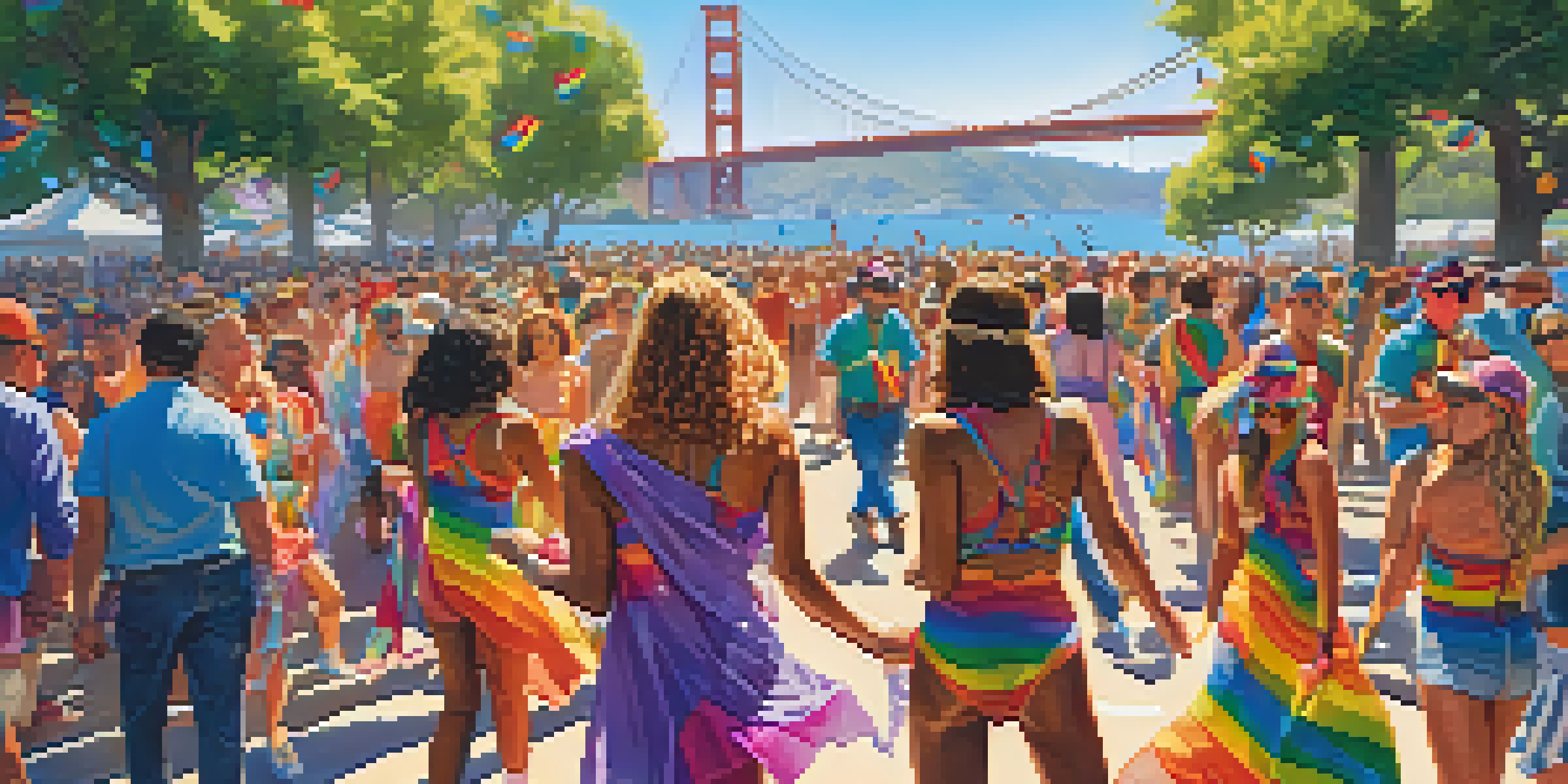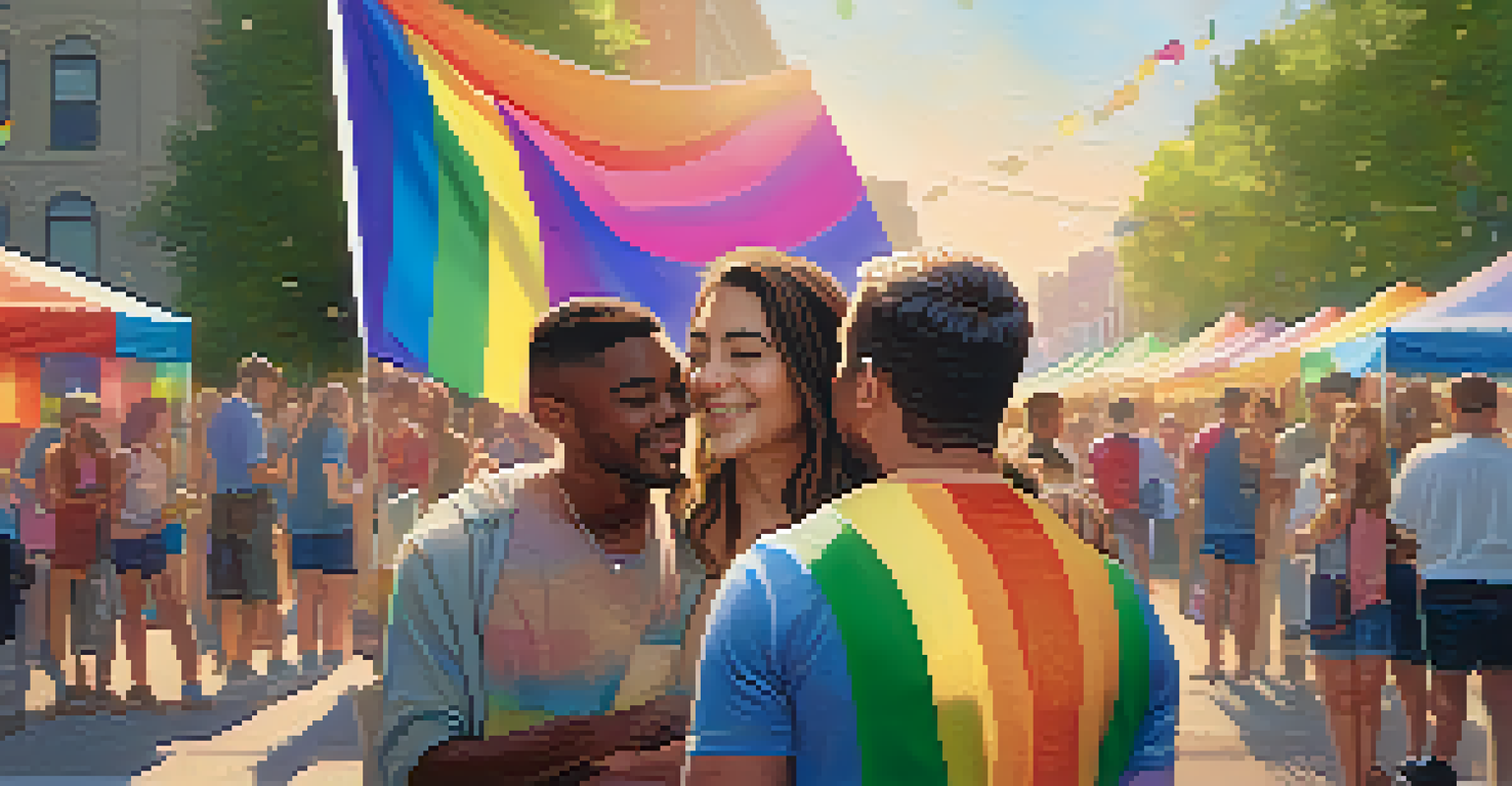California's LGBTQ+ Pride Festivals: Celebrating Diversity

Understanding the Essence of Pride Festivals
Pride festivals are more than just colorful parades; they are a celebration of identity, inclusivity, and history. Originating from the LGBTQ+ rights movement, these events signify the ongoing struggle for equality and acceptance. In California, where diversity is a hallmark, these festivals serve as a powerful reminder of the community's resilience and joy.
Pride is not just a celebration of who we are, but a reminder of the struggle for equality that continues today.
Each festival invites everyone, regardless of their background, to join in the festivities, fostering a sense of belonging. Participants often express themselves through vibrant outfits, art, and performances that showcase their unique identities and experiences. This collective celebration not only uplifts the LGBTQ+ community but also educates the public about its rich history.
Moreover, Pride festivals today are a blend of activism and celebration. They highlight issues still faced by the LGBTQ+ community, such as discrimination and violence, while also creating a space for joy and pride. This duality is what makes Pride such a crucial event annually.
The History of Pride Festivals in California
The roots of California's Pride festivals trace back to the late 1960s, particularly the Stonewall Riots in New York City, which ignited a global movement. In 1970, the first California Pride event, known as the Christopher Street West, took place in Los Angeles, marking a significant milestone in LGBTQ+ history. It aimed to honor the struggles faced by the community and to push for greater rights and recognition.

Over the years, California has become a beacon for LGBTQ+ culture, with numerous cities hosting their own unique celebrations. San Francisco's Pride, for example, has grown to be one of the largest in the world, drawing millions of attendees every year. These festivals not only commemorate past struggles but also celebrate the progress made in the fight for equality.
Pride Festivals Celebrate Identity
Pride festivals are vibrant celebrations that honor the LGBTQ+ community's identity, inclusivity, and history.
As the years have passed, the festivals have evolved, incorporating diverse themes and highlighting various issues within the LGBTQ+ community. This evolution reflects the changing societal attitudes and the ongoing fight for rights, making California's Pride festivals a living history of activism and celebration.
Iconic Pride Festivals Across California
From San Francisco to San Diego, California boasts a variety of iconic Pride festivals, each with its own flavor and character. San Francisco Pride is renowned for its grand parades and vibrant parties, making it a must-visit for anyone wanting to experience LGBTQ+ culture. The festival features a mix of community organizations, local businesses, and international guests, all coming together in a display of unity and pride.
In diversity there is beauty and there is strength.
In contrast, Los Angeles Pride focuses heavily on entertainment, with top-tier performances from popular artists and celebrities. The festival creates a festive atmosphere, where attendees can enjoy music and dance while celebrating their identities. This blend of entertainment and activism showcases the creativity and resilience of the LGBTQ+ community.
Meanwhile, smaller cities like Long Beach and Palm Springs also host their own Pride events, offering a more intimate experience. These festivals often highlight local LGBTQ+ issues and provide a platform for grassroots organizations, proving that pride is not just for big cities but is a vital part of every community.
The Role of Allies in Pride Festivals
Allies play a crucial role in the success of Pride festivals, helping to amplify the voices of LGBTQ+ individuals. Their participation is a clear demonstration of support and solidarity, highlighting the importance of community inclusivity. When allies join in the celebrations, they help foster a culture of acceptance that is essential for progress.
Moreover, allies can help bridge gaps between the LGBTQ+ community and those who may not fully understand its challenges. By engaging in conversations and participating in events, allies can educate themselves and others about LGBTQ+ issues, helping to dismantle stereotypes and misconceptions. This shared learning experience enriches the festival atmosphere.
California's Pride Has Rich History
California's Pride festivals have evolved since the late 1960s, reflecting a significant journey in the fight for LGBTQ+ rights.
The presence of allies also contributes to a safer environment for LGBTQ+ individuals to express themselves freely. Knowing that friends and family stand by their side empowers many to celebrate openly, making Pride festivals a true community event where everyone feels welcome.
Celebrating Intersectionality at Pride
Intersectionality is a vital aspect of Pride festivals, emphasizing that LGBTQ+ individuals come from diverse backgrounds, each with their own unique stories and struggles. California's Pride celebrations often highlight this diversity, showcasing the experiences of LGBTQ+ people of color, those with disabilities, and those from various cultural backgrounds. This inclusivity enriches the festival experience for everyone involved.
By celebrating intersectionality, Pride festivals encourage dialogue about the multifaceted nature of identity and the different challenges faced within the LGBTQ+ community. For example, organizations often set up booths and host discussions focusing on specific issues that intersect with race, gender, and socioeconomic status. This not only educates attendees but also fosters a greater understanding of the community as a whole.
As this commitment to intersectionality grows, Pride festivals become increasingly reflective of the diverse society we live in. By amplifying underrepresented voices, these events create a more inclusive environment, ensuring that everyone feels valued and seen during the celebrations.
The Impact of COVID-19 on Pride Festivals
The COVID-19 pandemic significantly affected Pride festivals across California, forcing many to adapt to new formats or cancel events altogether. In 2020, many cities transitioned to virtual celebrations, offering online parades and events that allowed the community to connect from the safety of their homes. While these digital events were a creative solution, they lacked the energy and connection of in-person celebrations.
As restrictions lifted in 2021, many festivals returned with a renewed sense of purpose, emphasizing resilience and community strength. Organizers focused on creating safe environments for attendees while ensuring that the spirit of Pride remained intact. This adaptability showcased the community's strength and determination to celebrate diversity, even in challenging times.
Allies Enhance Pride Celebrations
The participation of allies at Pride festivals fosters community support and promotes inclusivity, making the celebrations more meaningful.
Now, as we move forward, the impact of COVID-19 has led to a reevaluation of how Pride festivals are organized. Many events are incorporating hybrid models, allowing for both in-person and virtual participation. This evolution not only broadens the reach of Pride celebrations but also ensures that everyone can participate, regardless of their circumstances.
Looking Ahead: The Future of Pride Festivals in California
As we look to the future, California's Pride festivals are poised to continue evolving, reflecting the needs and desires of the community. With ongoing discussions about rights and representation, these events will likely adapt to highlight emerging conversations within the LGBTQ+ landscape. This adaptability ensures that Pride remains relevant and impactful for future generations.
Moreover, the emphasis on inclusivity and intersectionality will likely deepen, fostering a more comprehensive understanding of the diverse experiences within the LGBTQ+ community. As new voices join the conversation, the festivals can become even richer in culture and advocacy, promoting a sense of unity among all participants.

Ultimately, California's Pride festivals will continue to be a source of joy, education, and activism. As we celebrate the past and present, these gatherings will inspire future movements, ensuring that the fight for equality and acceptance continues.